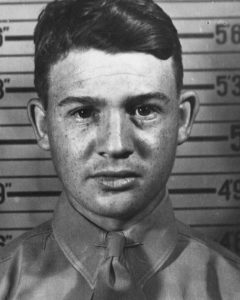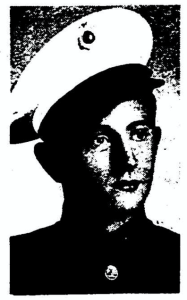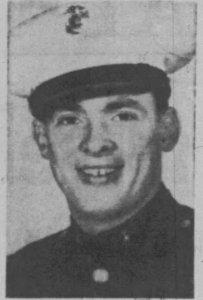Leonard D. Hulbert from Wisconsin, Racine county.
Service era: World War II
Date of death: January 28, 1945
Death details: Killed in action
Source: National Archives, family

Promote & Preserve stories of U.S. fallen soldiers/sailors
Leonard D. Hulbert from Wisconsin, Racine county.
Service era: World War II
Date of death: January 28, 1945
Death details: Killed in action
Source: National Archives, family
Gordon Robert Myers, age 30, from Racine County Wisconsin.
Parents: Eda M. Myers
Service era: World War II
Date of death: Friday, December 15, 1944
Death details: On December 13, 1944, Japanese forces in the Philippines began the transfer of 1,621 Allied prisoners of war (POWs) to Japan. The POWs were to make the journey aboard transport ships whose harsh conditions and extreme overcrowding led survivors to refer to them as “Hell Ships.” The ships also lacked markings that would distinguish them from any other military target, causing some of them to be attacked by Allied forces who could not identify them as POW transports. On December 14, 1944, Allied aircraft attacked the first ship, the Oryoku Maru, in Subic Bay in the Philippines, killing many Allied POWs who became lost in the water, sank with the ship, or were washed ashore. Survivors of the bombing were put aboard two other ships, the Enoura Maru and the Brazil Maru, to continue on to Japan. During the journey, while anchored in Takao Harbor, Formosa (present-day Taiwan), the Enoura Maru was attacked by Allied aircraft from the USS Hornet (CV-8), killing Allied POWs who were lost in the water, on board the ship, or on the nearby shore. Survivors of the Enoura Maru bombing were loaded onto the Brazil Maru, and reached Japan on January 30, 1945. As a result of these incidents, Allied POWs were lost in the Philippines, at sea between the Philippines and Taiwan, while anchored in Taiwan, at sea between Taiwan and Japan, and in Japan. The attacks on these POW transports ultimately resulted in a series of death notifications from the Japanese government through the International Red Cross (IRC), and some casualties were given up to five different dates of death at various locations during the transfer. Witness accounts from surviving POWs offer detailed information for a handful of casualties, but the specific dates of loss and/or last-known locations for many of these POWs are based on the most recent reported date of death. Captain Gordon R. Myers entered the U.S. Army from Wisconsin and served with the 2nd Battalion, 52nd Infantry Regiment, 51st Infantry Division. Captured by the Japanese in the spring of 1942, CPT Myers is believed to have died during the attack on the Japanese transport ship Enoura Maru on January 9, 1945. He has not been associated with any remains recovered from the area after the war and is still unaccounted-for. Today, Captain Myers is memorialized on the Walls of the Missing at Manila American Cemetery and Memorial in the Philippines.
Source: National Archives, Defense POW/MIA Accounting Agency, Journal Times (1945)
Ralph H. Bode from Wisconsin, Racine county.
Service era: World War II
Date of death: Wednesday, September 27, 1944
Death details: Finding of death
Cemetery: Luxembourg American Cemetery
Source: National Archives, American Battle Monuments Commission, Defense POW/MIA Accounting Agency

James Hugh Clemons, age 19, from Wisconsin, Racine county.
Service era: World War II
Date of death: Saturday, November 20, 1943
Death details: From November 20 through 23, 1943, the U.S. Marine Corps and U.S. Navy conducted a large-scale amphibious assault on the Japanese-held atoll of Tarawa as part of Operation Galvanic, the Allied capture of the Gilbert Islands. Located 2,500 miles southwest of Hawaii, Tarawa was a crucial stepping stone in the planned U.S. offensive across the central Pacific toward Japan. The Japanese garrison on Tarawa’s main island of Betio was well-entrenched with hundreds of bunkers and gun positions behind formidable beach obstacles. The first wave of Marines approaching the shore encountered lower-than-expected tides, forcing them to leave their landing craft on the reef and wade the hundreds of yards to the beach under intense enemy fire. The heaviest number of U.S. casualties were suffered during this phase of the landing. Eventually, rising tides allowed U.S. warships to maneuver closer to shore and support the troops with effective naval gunfire. More Marines landed on the second day, launching attacks inland from the beaches and seizing the Japanese airfield on the island. However, the enemy launched vicious counterattacks and two more days of intense fighting were needed to secure Betio. The last enemy strongpoints were taken on the morning of November 23. The fighting on Betio cost the Marines nearly 3,000 casualties but enabled U.S. forces to press further across the Pacific and yielded valuable tactical lessons that reduced U.S. losses in future amphibious landings. Corporal James H. Clemons, who entered the U.S. Marine Corps from North Carolina, served with Company C, 2nd Amphibious Tractor Battalion, 2nd Marine Division at the time of the assault on Tarawa. He was killed in action against Japanese forces on Tarawa on November 20 and was buried on Betio Island, but subsequent searches were unable to recover any remains which could be identified as his. Today, Corporal Clemons is memorialized in the Courts of the Missing at the National Memorial Cemetery of the Pacific.
Source: National Archives, Defense POW/MIA Accounting Agency

David Robert Harcus, age 19, from Racine, Wisconsin, Racine county.
Spouse: Married
Service era: World War II
Date of death: Saturday, November 20, 1943
Death details: From November 20 through 23, 1943, the U.S. Marine Corps and U.S. Navy conducted a large-scale amphibious assault on the Japanese-held atoll of Tarawa as part of Operation Galvanic, the Allied capture of the Gilbert Islands. Located 2,500 miles southwest of Hawaii, Tarawa was a crucial stepping stone in the planned U.S. offensive across the central Pacific toward Japan. The Japanese garrison on Tarawa’s main island of Betio was well-entrenched with hundreds of bunkers and gun positions behind formidable beach obstacles. The first wave of Marines approaching the shore encountered lower-than-expected tides, forcing them to leave their landing craft on the reef and wade the hundreds of yards to the beach under intense enemy fire. The heaviest number of U.S. casualties were suffered during this phase of the landing. Eventually, rising tides allowed U.S. warships to maneuver closer to shore and support the troops with effective naval gunfire. More Marines landed on the second day, launching attacks inland from the beaches and seizing the Japanese airfield on the island. However, the enemy launched vicious counterattacks and two more days of intense fighting were needed to secure Betio. The last enemy strongpoints were taken on the morning of November 23. The fighting on Betio cost the Marines nearly 3,000 casualties but enabled U.S. forces to press further across the Pacific and yielded valuable tactical lessons that reduced U.S. losses in future amphibious landings. Private David R. Harcus entered the U.S. Marine Corps from Wisconsin and served in Company L, 3rd Battalion, 2nd Marine Regiment, 2nd Marine Division. He was killed in action on November 20, during the Battle of Tarawa. Private Harcus was buried on Betio Island, but his remains could not be identified among those disinterred from the island following the war. Private Harcus is memorialized on the Courts of the Missing at the National Memorial Cemetery of the Pacific.
Source: National Archives, Defense POW/MIA Accounting Agency

Robert Eugene Liertz, age 21, from Racine, Wisconsin, Racine county.
Parents: Maude Liertz
Service era: World War II
Date of death: Saturday, November 20, 1943
Death details: From November 20 through 23, 1943, the U.S. Marine Corps and U.S. Navy conducted a large-scale amphibious assault on the Japanese-held atoll of Tarawa as part of Operation Galvanic, the Allied capture of the Gilbert Islands. Located 2,500 miles southwest of Hawaii, Tarawa was a crucial stepping stone in the planned U.S. offensive across the central Pacific toward Japan. The Japanese garrison on Tarawa’s main island of Betio was well-entrenched with hundreds of bunkers and gun positions behind formidable beach obstacles. The first wave of Marines approaching the shore encountered lower-than-expected tides, forcing them to leave their landing craft on the reef and wade the hundreds of yards to the beach under intense enemy fire. The heaviest number of U.S. casualties were suffered during this phase of the landing. Eventually, rising tides allowed U.S. warships to maneuver closer to shore and support the troops with effective naval gunfire. More Marines landed on the second day, launching attacks inland from the beaches and seizing the Japanese airfield on the island. However, the enemy launched vicious counterattacks and two more days of intense fighting were needed to secure Betio. The last enemy strongpoints were taken on the morning of November 23. The fighting on Betio cost the Marines nearly 3,000 casualties but enabled U.S. forces to press further across the Pacific and yielded valuable tactical lessons that reduced U.S. losses in future amphibious landings. Private First Class Robert Eugene Liertz entered the U.S. Marine Corps from Wisconsin and served in Company K of the 3rd Battalion, 8th Marine Regiment, 2nd Marine Division. He was killed in action during the Battle of Tarawa on November 20, 1943. Private First Class Liertz was buried in Cemetery #33, Main Marine Cemetery, but he could not be identified among remains recovered from Tarawa after the war. Today, Private First Class Liertz is memorialized on the Courts of the Missing at the National Memorial Cemetery of the Pacific.
Source: National Archives, Defense POW/MIA Accounting Agency
Charles A. Ganz, age 31, from Burlington, Wisconsin, Racine county.
Service era: World War I
Date of death: Monday, November 18, 1918
Death details: Died of disease
Source: Soldiers of the Great War, findagrave.com
Victor Gecenice from Racine County Racine, Wisconsin .
Service era: World War I
Date of death: Friday, August 2, 1918
Death details: Died of accident
Source: Soldiers of the Great War